Rome Diary - Part IV
May 19
The City of Rome excursion to Porta Maggiore stopped off at a tomb to three freed slaves, a married couple plus “concubine”, laid to rest in a perpetual menage-a-trois on a street corner opposite a strangely named hotel that could be the set for a B-grade horror movie.

Photo: Hotel Bled, Rome.
(Named after a lake in Slovenia, 30 km north of Ljublijana.)
This might be the place to comment on the fascination current at the British School at Rome for Big Love, an American TV drama about a fundamentalist Mormon family that practises polygamy. Who would have guessed?!
Back to the excursion... Daniel, one of the City of Rome scholars, gave a presentation on the Baker’s Tomb - a funerary monument erected by a freed slave who was proud of his job. (See April 14 entry for pic and more details)

Photo: Approaching Porta Maggiore (background left).
This roadside memorial found itself in front of the Porta Maggiore, a twin gate in the Claudian Aqueduct that then hosted a propagandising inscription from Titus, declaring its restoration, before being incorporated into the Aurelian wall.

Photo: Porta Maggiore (from inside the Aurelian wall).
The Porta Maggiore is constructed from travertine, which Robert Coates-Stephens pointed out is a limestone deposit made by the passage of water. There is a poetic aspect to the use of this “solid water” in monumentalising the provision of running water to the city.
Christopher Smith’s lecture came to mind regarding the “strong magic” associated with running water as well as the transgression inherent with crossing over the same at the Tiber Island ford, (whose function is fundamental to the origin of the city). While the aqueduct span has become something of a victory arch at Porta Maggiore, celebrating a Roman triumph over nature, I am struck by the symbolism in the passage of running water above the city and in its citizens passing under it at this gate.
However you look at it, the aqueduct is a crowning Roman achievement.
While the group had a coffee break, I wandered off to check out a less celebrated and more contemporary example of elevated infrastructure nearby.

Photo: Freeway overpass near Porta Maggiore.
As a consequence I lost the group...
But I found an interesting structure as I followed the train line home - a late Imperial nymphaeum mistakenly named The Temple of Minerva Medica. Apparently nymphs were often connected with the water supply.

Photo: “Temple of Minerva Medica”
In the evening I went with some of the BSR artists to an opening at The MAXXI - National Museum of XXI Century Art. The gallery was designed by Zaha Hadid and looks a lot like a truncated freeway interchange.

Photo: The MAXXI - National Museum of XXI Century Art.
I found the impact of the building more striking then its contents, although a retrospective on the Dutch minimalist architect and designer, Gerrit Rietveld, and his ingeniously simple maquettes and Constructivist chairs was worth the visit. The structure’s bold imposition in the historical landscape reminded me of blank swatches in ancient frescos that replace the areas lost to time.
May 21
Went to Tivoli on the day that an 89 year old Californian doomsday preacher was predicting the end of the world. This ancient town is located 30 km north east of Rome, in the hills where the Tiber River originates, and provides spectacular views over the Campagna. It seemed like a great place to spend one’s final day on earth.
We visited Hadrian’s Villa in the morning, a complex of over 30 buildings constructed as a retreat for the Roman emperor early in the second century AD.

Photo: Doomsday at Hadrian’s Villa Tivoli. (Daniel Wroe)

Photo: Temple of Venus with copy of the Aphrodite of Knidos.
(I didn’t think her buttocks were that beautiful!)
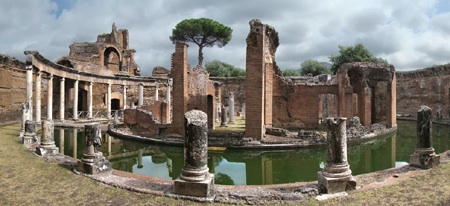
Photo: The Maritime Theatre, a moat secures a villa within a villa,
and may have been conceived as a model of the world.

Photo: The Thermae
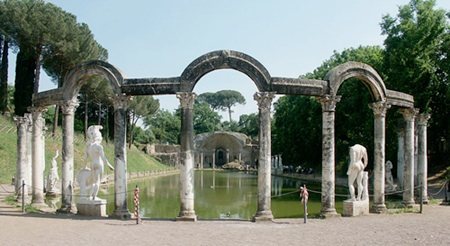
Photo: The Canopus, looking toward the Serapeum.

Photo: The Serapeum - an open-air, domed apse for summer dining.
Water cascaded out of the windows and around the reclining guests
providing an air-con effect... and discomfort for those with weak bladders.
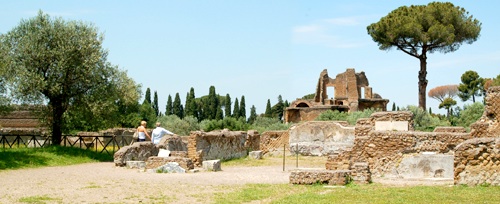
Photo: The Greek Library.
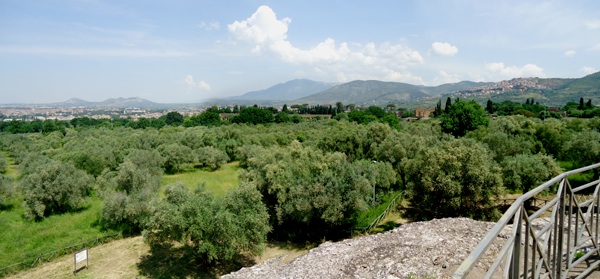
Photo: The rooftop view of the Campagna, from which Hadrian could have seen
his tomb being constructed on the horizon.
We had a nice lunch followed by grapa and a leisurely stroll through the town.
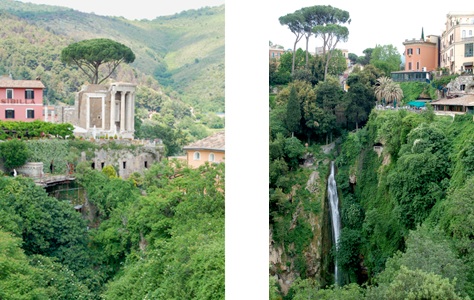
Photo: The Temple of Vesta, left and view from it, right.

Photo: Daniel, a medievalist, gets excited by the discovery of a Gothic House in Tivoli.
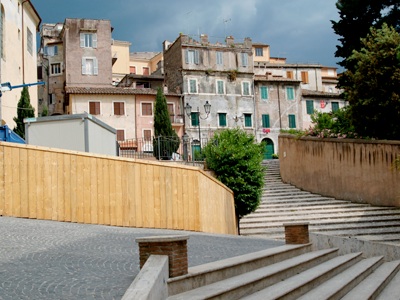
Photo: View from the steps of San Pietra alla Carita.
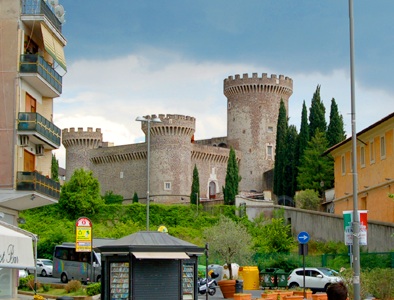
Photo: A castle of some description.
A thunderstorm hit on the return bus journey, but no brimstone was involved.
Joey, the longest term resident artist here, made a terrific dinner for over a dozen guests, and we wandered over to a street party being organised by the Dutch school opposite. I am sure that some will wake feeling like they had been judged by God for their evening’s excesses, but the apocalypse was averted for another day in the Eternal City.
May 24
Visited churches dedicated to local martyrs, St Agnes and St Lawrence.
St Agnes of Rome (c. 291 - 304) was, according to tradition, a 12-13 year old virgin, sentenced to death for refusing to marry the Prefect’s son. As Roman Law did not permit the execution of virgins, she was dragged to a brothel where a profuse gorilla-like growth of hair covered her nakedness and repulsed those who would violate her. Sadly, she was beheaded anyway and buried in a catacomb. The daughter of Constantine, it is claimed, was cured of leprosy after praying at her tomb and was entombed in a fourth century mausoleum built next to it.
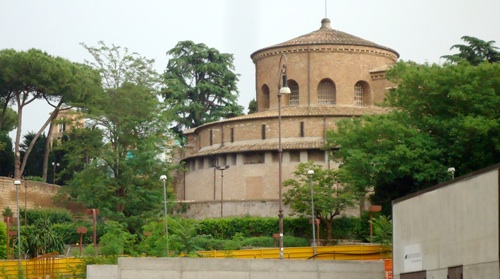
Photo: The Mausoleum of Constantina (Santa Constanza).
(The tower of the Basilica of St Agnes Beyond the Walls is visible through the trees on the left.)
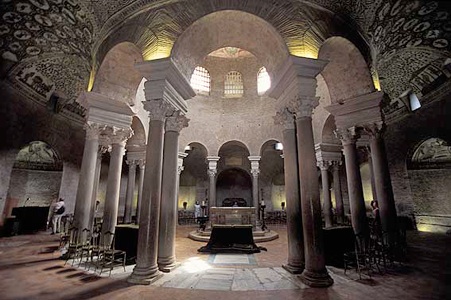
Photo: Inside the Mausoleum of Constantina (Santa Constanza).
This mausoleum became a church in the middle ages. It contains apse mosaics. One depicts Jesus as a young, clean shaven Apollo-like figure. The other, one the wall opposite, portrays him in an older, bearded, Zeuss-like guise sitting on a globe. This duality brings to mind the complex dialogue between the temples to Jupiter and Vejovis (younger Jupiter?) on the Capitoline.
I thought the mosaics looked a bit like eyes!

Photo: Apse Mosaics from Santa Constanza.
Next door is The Basilica to St Agnes Outside the Walls (Sant’Agnes fuori le Mura). The hill covering St Agnes tomb was removed in a Trajan-style excavation,to build this seventh century church over it. Windows around the top allows heavenly light to descend, while the saint’s tomb below the altar shares its magic radiance. The gold in the apse mosaic emphasises the dynamic quality of light. Its depiction of saints exchanges the life-like modelling of the three-quarter view for a more iconic form, however the concave surface echoes that of the retina, and may reflect an optical concern that fascinated Greek architects for subtle curves that appear straight.
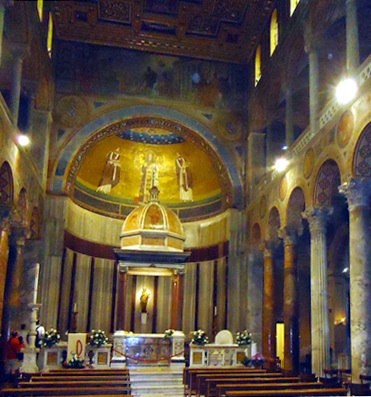
Photo: Inside Sant’Agnes fuori le Mura.
The Basilica of St Lawrence Outside of the Walls (San Lorenzo fuori le Mura) was built in the 580’s, and also locates its altar like a “lift shaft” over the mortal remains of the saint. [To quote Dr Robert Coates-Stephens.]
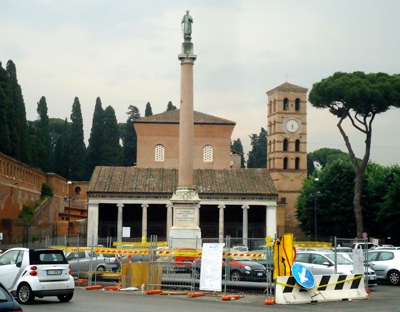
Photo: San Lorenzo fuori le Mura.
St Laurence (c. 225 - 258) was the keeper of the Holy Grail and church treasurer who gave it all to the poor when the Roman Prefect demanded he hand over the church’s wealth to the state. As a consequence he was BBQed to death on a massive gridiron. According to the legend this was interrupted with Lawrence saying, “Turn me over. I’m done on this side.”
The church was extended in the 13th century with a second structure, damaged by an American bomb in the second world war.
The original structure was made by using columns and reliefs from previous buildings. This recycled spoilia includes a depiction of Roman spoils of war carved in one of the capitals, with armour arranged in the shape of a crucifix. This seems to symbolise the re-appropriation taking place in Christianising Rome as well as the strange mix of martyrdom and charity with wealth and power.

Photo: The spoils of war represented in spoilia at San Lorenzo fuori le Mura.
The artists opened up their studios in the evening for the City of Rome scholars. It seemed like a nice way to celebrate my birthday!
25 May
Attended the American Academy in Rome’s upmarket open studio, that included a couple of upmarket artists.
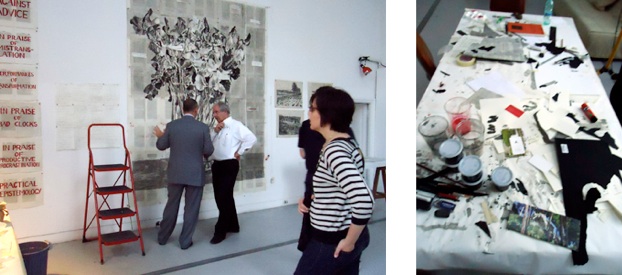
Photo: William Kentridge (white shirt) in his studio and his work table.
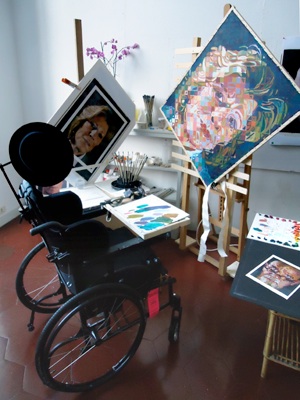
Photo: This was as Close as I got to Chuck!
I spied the Tempietto, a small circular chapel by Bramante (c. 1502) through a locked gate at the Spanish Academy nearby.

Photo: The Tempietto in late afternoon and evening light.
26 May
Last excursion with City of Rome scholars.
Visited the House of the Knights of Rhodes/Malta, located above Trajan’s Market. Started with a chapel in the basement dedicated to St John the Baptist, then wandered through the offices upstairs with a head of Zeus on the wall flanked by two caryatids, and out onto a balcony that offered great views over the Imperial Forums.
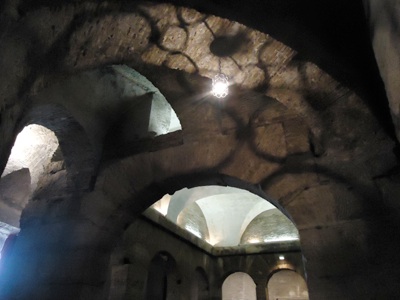
Photo: Arches in the Chapel to St John The Baptist.
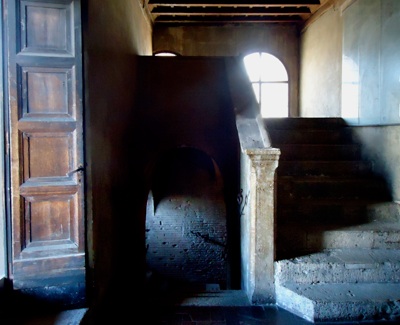
Photo: Stairwell in the House of the Knights of Rhodes.
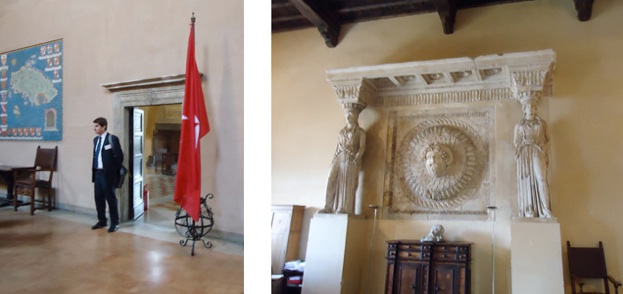

and of the medieval tower The Torre delle Milizie (below).

We crossed the road to visit the remains of the Temple of Castor and Pollux in the Forum. According to legend the Gemini twins aided the Romans in battle and then appeared in the Forum watering their horses at a spring in front of the site, marked now by the three surviving pillars.

Photo: The Temple of Castor and Pollux, The Forum.
The records office for the Aqueducts was located opposite along with a small shrine to Juturna the goddess of fountains, wells and springs.
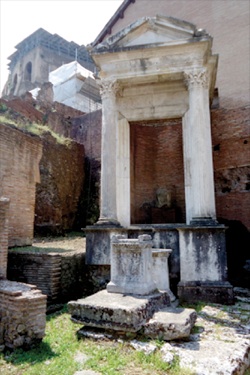
Photo: Shrine to Juturna, The Forum.
Water becomes a less positive theme in the small oratory hall next door. A seventh century fresco shows Christians being forced to stand in icy water. Some receive crowns of martyrdom while another renounces their faith in exchange for a hot bath.
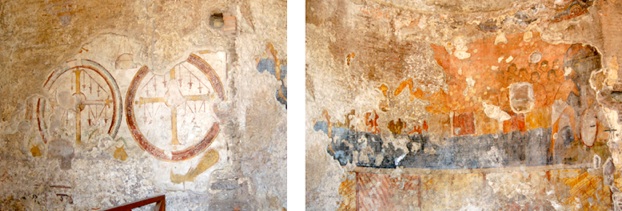
Photo: Jewelled crowns (left) Figure exits the icy water torture (right) for a hot bath, 7th century fresco.
The two month long City of Rome Intensive, ended at the misnamed Temple of Romulus, a round temple that faces on to the Via Sacra in The Forum, with a fourth century hall attached.
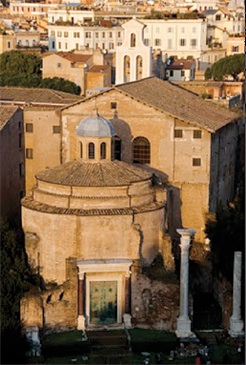
Photo: “Temple to Romulus” and Santi Cosma e Damiano.
The rectangular hall became a Christianised basilica in the 6th century, dedicated to third century martyrs, Greek physicians, and twin brothers Cosmas and Damian - one suspects as a response to the Gemini twins, Castor and Pollux at the temple across the way.
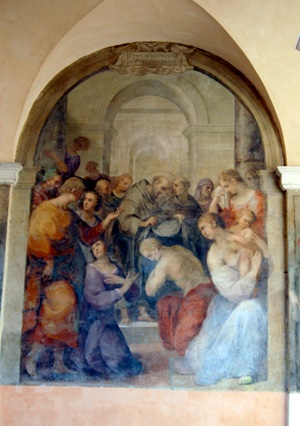
Photo: Fresco depicting arches within arches in portico of Santi Cosma e Damiano.
The apse mosaic depicts the second coming of Christ. An apocalyptic theme continues on the arch in front of this, referencing symbols from the book of Revelation, associated by some to the Roman empire and its fall.
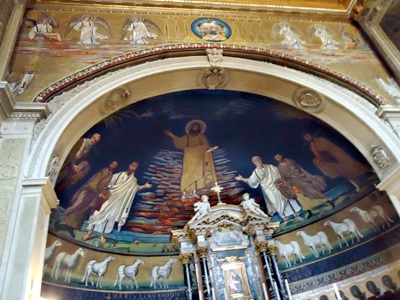
Photo: Apse mosaic Santi Cosma e Damiano.
The round room that separates the church from the Forum contains a Pantheon-like ”oculus”. A film montage was screening inside of various Hollywood depictions of Nero, the extravagant and tyrannical Emperor who infamously “fiddled while Rome burned”.
This seemed like an appropriate ending point to the course.
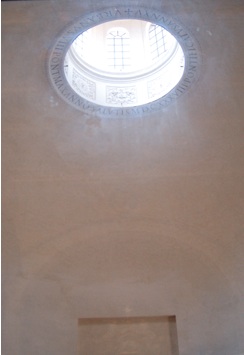
Photo: Skylight in the dome of the “Temple to Romulus”.
Enjoyed final drinks with the students and Dr Robert in the evening, extremely grateful for the informative experience and the company of such a bright and energetic group.
27 May
The students left in waves throughout the day. It was sad to see them go, especially considering I would be doing the same in one month’s time.
One of the long term scholars, Ellen, was having her birthday on Saturday, and since she was also Australian we hosted a twin Gemini BBQ in the evening with a poster of Pope John Paul holding a koala.

“How much can a koala bear?”
28 May
Enjoyed a pleasant night out at a local restaurant celebrating Ellen’s birthday.
